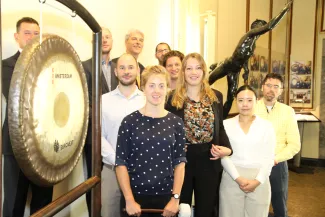-
Listing
-
Trading
 Where European Government Bonds meet the futureFixed Income derivativesRead more
Where European Government Bonds meet the futureFixed Income derivativesRead moreTrade Mini Bond Futures on main European Government Bonds
-
Clearing
 Step into Europe’s next phase of Repo ClearingRepo ClearingRead more
Step into Europe’s next phase of Repo ClearingRepo ClearingRead moreEuronext is expanding its repo clearing services to boost market access, liquidity provision and collateral optimisation across Europe.
-
CSD
 European CSD modelBuilding the CSD of Choice in EuropeRead more
European CSD modelBuilding the CSD of Choice in EuropeRead moreEuronext Securities is shaping the future of European capital markets by enhancing integration, connectivity, and innovation.
-
Technology
 Euronext Technology SolutionsHigh-Frequency Trading Solution (HFTS)Read more
Euronext Technology SolutionsHigh-Frequency Trading Solution (HFTS)Read moreThe new generation of high-frequency risk trading platforms, offering the highest performance with ultra-low latency and minimal jitter, all at a low total cost of ownership.
-
Data
-
Indices
 Access the white paperInvesting in the future of Europe with innovative indicesRead more
Access the white paperInvesting in the future of Europe with innovative indicesRead moreThe first edition of the Euronext Index Outlook series with a particular focus on the European Strategic Autonomy Index.
- Regulation
-
About Euronext
 Euronext strategic planInnovate for Growth 2027Read more
Euronext strategic planInnovate for Growth 2027Read moreShaping capital markets for future generations
-
Listing
-
Trading
 Where European Government Bonds meet the futureFixed Income derivativesRead more
Where European Government Bonds meet the futureFixed Income derivativesRead moreTrade Mini Bond Futures on main European Government Bonds
-
Clearing
 Step into Europe’s next phase of Repo ClearingRepo ClearingRead more
Step into Europe’s next phase of Repo ClearingRepo ClearingRead moreEuronext is expanding its repo clearing services to boost market access, liquidity provision and collateral optimisation across Europe.
-
CSD
 European CSD modelBuilding the CSD of Choice in EuropeRead more
European CSD modelBuilding the CSD of Choice in EuropeRead moreEuronext Securities is shaping the future of European capital markets by enhancing integration, connectivity, and innovation.
-
Technology
 Euronext Technology SolutionsHigh-Frequency Trading Solution (HFTS)Read more
Euronext Technology SolutionsHigh-Frequency Trading Solution (HFTS)Read moreThe new generation of high-frequency risk trading platforms, offering the highest performance with ultra-low latency and minimal jitter, all at a low total cost of ownership.
-
Data
-
Indices
 Access the white paperInvesting in the future of Europe with innovative indicesRead more
Access the white paperInvesting in the future of Europe with innovative indicesRead moreThe first edition of the Euronext Index Outlook series with a particular focus on the European Strategic Autonomy Index.
- Regulation
-
About Euronext
 Euronext strategic planInnovate for Growth 2027Read more
Euronext strategic planInnovate for Growth 2027Read moreShaping capital markets for future generations
- Home
- About
- Media centre
- Bell Ceremony Archive
- KVK Innovation Top 100 – PHYSEE is the winner
KVK Innovation Top 100 – PHYSEE is the winner
30/09/2019

PHYSEE in Delft with Smartskin, a glass façade with integrated solar cells and sensors, wins the 14th edition of the KVK Innovation Top 100. This is why Grace Copplestone, Supply Chain Manager at PHYSEE, together with KVK sounds the gong.
About KVK Innovation Top 100
KVK publishes this ranking annually with 100 innovations in Dutch small and medium-sized businesses. The winner can call himself the most innovative SME company in the country for a year.
All innovations have been assessed for their impact on the industry and society, originality, availability, realized turnover and growth potential. There is no cash prize attached to the KVK Innovation Top 100. The ranking gives a good picture of the innovative power of SMEs at the moment. North and South Holland are represented the best with 22 companies, followed by Gelderland with 14 companies. After the IT sector, most innovations came from the creative industry and construction sectors. The announcement of the 14th Chamber of Commerce Innovation Top 100 took place in the Amsterdome in Amsterdam.
About PHYSEE
Where the glass industry was not interested at first, glass producers are now starting to show more and more interest. From a small start-up, PHYSEE has now become a scale-up with more than 30 employees from 10 countries. The first international assignments are now starting to come in. TU Delft is a shareholder and partner in this company. The jury was unanimous: "It is seen as a breakthrough technology for the world. Every architect can apply it this way. PHYSEE stands for a future in which buildings become energy positive without compromising on the aesthetics of the facades. That makes this company a justified winner. "
PHYSEE's patented invention consists of solar cells in the glass that generate electricity and sensors that make the glass smart. The solar cells ensure that there is always green energy in the facade. The sensors measure environmental data such as temperature, light and air quality and use this information to cool, heat and illuminate buildings in a more energy-efficient way. Thus, buildings become 25% more energy efficient and comfortable.

